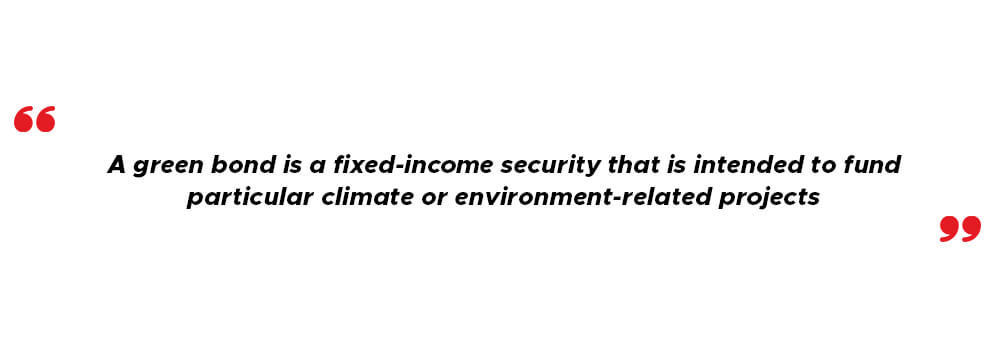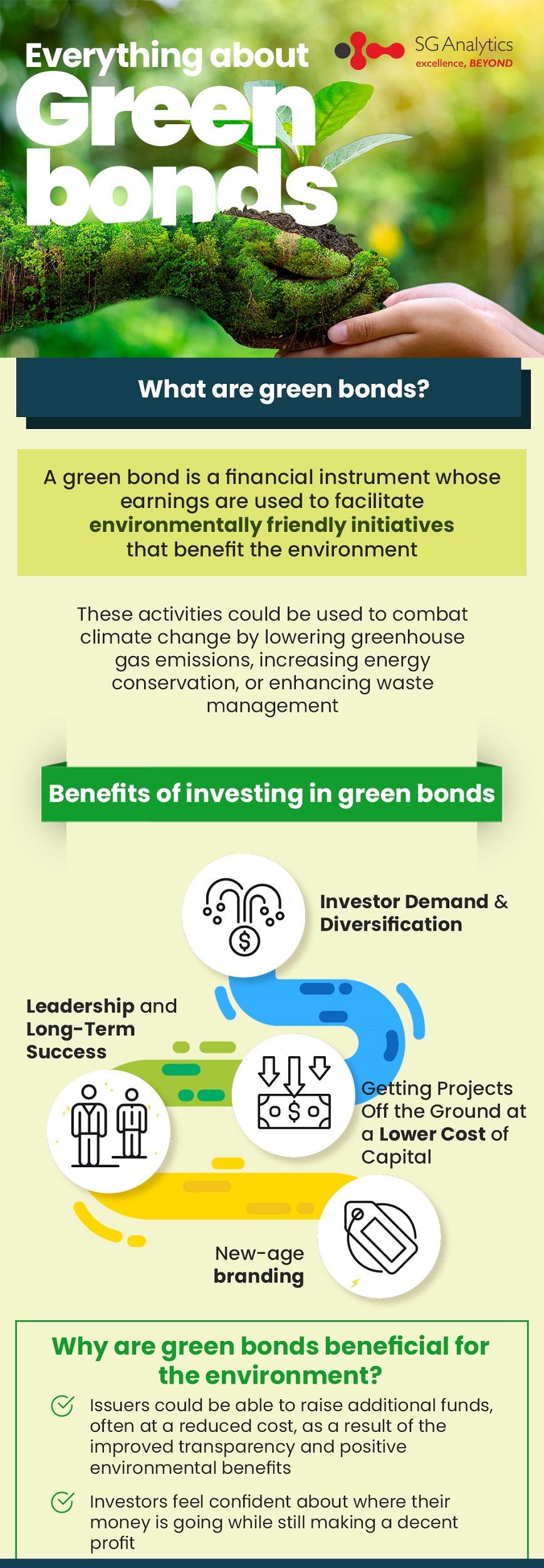Green bonds are quickly gaining popularity as a way for businesses to raise funds for projects, assets, or other initiatives that support the economy, climate, or community. Governments have begun to foster the growth of the green bond market, and investors have flocked to ‘green’ investments, raising interest to new heights in the recent years.
To combat global warming, trillions of dollars would be required. Green bonds are a way for issuers to raise funds for environmentally friendly programmes like renewable energy or clean transportation while still being able to talk openly about it. The bonds are also appealing to fund managers since they view it as a way to satisfy growing investor demand for sustainable investments. The sector, which slowly started gaining momentum a decade ago, has recently exploded, and has aided in the growth of other debt-related socially conscious products.
Since it’s difficult for investors to tell if a bond is actually green, regulators put increased emphasis on standards to prevent greenwashing, or making false statements about how environmentally friendly an issuer is.
What are green bonds?
A green bond is a fixed-income security that is intended to fund particular climate or environment-related projects. Green bonds are typically accompanied by tax benefits that make them more appealing to investors. The first certified green bond was issued by the World Bank in 2009. A green bond is a financial instrument whose earnings are used to facilitate environmentally friendly initiatives that benefit the environment. These activities could be used to combat climate change by lowering greenhouse gas emissions, increasing energy conservation, or enhancing waste management.

The green bond market has exploded, with annual global issuance increasing more than double in the last five years. It requires a benchmark borrower to become a fully functioning asset class. That’s a job that the European Union is well positioned to perform by selling environmentally friendly debt as it ramps up its bond-issuing campaign to help the region recover from the pandemic.
The global green bond market is expected to rise to 1 trillion euros (US$1.22 trillion) in 2021, according to NN Investment Partners. The EU Taxonomy and EU Green Bond Standard, which derive from the European Union’s Sustainable Action Plan to fund sustainable economic development, are driving the growth of the market.

The creation of the first edition of the EU Taxonomy and EU Green Bond Standard will have a long-term positive effect on the EU green bond market’s credibility and transparency, and will serve as a framework for regulatory reform in other regions.
The new regulations will further centralize and formalize the green bond market which is maturing rapidly. It will also help raise awareness about the economic practices that are environmentally friendly and how businesses and investors can adapt them to become more sustainable. Additionally, it will provide investors with a more comprehensive analysis of their investments, allowing them to make more informed decisions.
Benefits of investing in green bonds
Green bonds offer investors the opportunity to gain tax-free income while also ensuring that their money is being put to good use. As the demand of Green bond keeps increasing, it correlates to lower borrowing rates. Lower borrowing costs mean lower expenses, which are either passed on to investors as a dividend or used to offset the operating costs of exchange-traded funds (ETFs) or bonds. Here are some of the benefits of investing in green bonds:
Investor Demand and Diversification
Investors are rapidly demanding socially responsible investment (SRI) opportunities and have consistently oversubscribed green bond issuances, demonstrating a strong appetite for green bonds. Institutional investors are using green bonds to tackle ESG (Environmental, Social, and Governance) agendas, while retail investors seek sustainable investments from their brokers and fund managers. As a response, green bond issuances have intrigued new investors and various different types of investors, potentially expanding the demand for future green bond issuances.
Getting Projects Off the Ground at a Lower Cost of Capital
Green bonds are an ideal way to raise substantial sums of money to fund sustainable investments that would otherwise be unavailable or unprofitable with more costly capital. Green bonds are very well appropriate for large-scale sustainability projects like development of wind and solar plants, which often require capital investment prior to revenue generation and produce moderate profit over a longer investment horizon.
Leadership
Green bond issuers will continue to lead the way in this sector for the near future. They will motivate other municipalities to join and develop a reputation for financial innovation. The nation’s early adopters would pave the way for the rest of the country to fund environmental programmes. Working groups and coalitions that shape the market, create standards, and ensure long-term success may also include government leaders.
New-age branding
Green Bonds enable governments to position themselves as forward-thinking, creative, and environmentally conscious. Green bond issues continue to receive favourable coverage in the media.

How do green bonds work?
A bond is basically a fixed-term, fixed-interest loan from one party to another. For example, a green bond investor wants to loan certain green bond for $5,000 over the course of five years. He/She will earn a 6% annual return, or $300 in interest, over the course of those 5 years. They’d even get the $5,000 back at the end of the five years. During this time, the amount will be invested in renewable energy projects (wind, solar, hydro, etc.) that would reduce greenhouse gas emissions while still providing sufficient return to cover the interest payments.

Why are green bonds beneficial for the environment?
Fighting climate change can necessitate a large sum of money, and green bonds provide a capital alternative that appeals to both issuers and investors. Issuers could be able to raise additional funds, often at a reduced cost, as a result of the improved transparency and positive environmental benefits. Investors should feel confident about where their money is going while still making a decent profit.
Green bonds: Good investment opportunity?
It all depends on one’s risk tolerance and investment objectives. Bonds (also known as fixed income) are seen as a less risky investment than purchasing a company’s stock (or equity). They also have a guaranteed return, unlike equity, and can provide additional protection from risks. Green bonds may be an excellent choice for an investor who wants a steady return with potentially lower risk, as well as the assurance that their money is being used to directly combat climate change – particularly in these uncertain economic times.
Issuing green bonds would favour solar energy industry participants in particular. Demonstrating the proceeds that would be used for ‘green’ purposes could be challenging for some companies trying to harness investor demand for green bonds. Solar energy projects are, fortunately, specifically identified as a qualifying field for green bond financing by current green bond criteria.

Conclusion
Despite the current economic turmoil, green bonds are projected to see long-term growth in volume and use around the world. Participants in the solar energy industry should seriously consider green bonds to fund solar projects and related facilities, such as storage. Green bonds should be on the minds of all solar energy industry participants due to increased investor demand, corporate goodwill, and possible pricing advantages, as well as relatively low start-up costs and solar energy’s natural qualification for green bond financing.
Anything that can be done to encourage the issuing of green bonds to fund green projects as a tool for combating the catastrophic effects of climate change should be done, with the government, issuers, investors, and other market participants.









